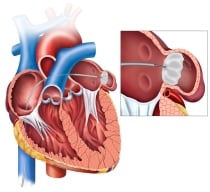Explaining the Watchman Procedure
Medically Reviewed by Prabal K. Guha, MD
People with atrial fibrillation (or Afib) have 3 to 5 times greater risk for ischemic stroke. The left atrial appendage, a small pouch located on the top of the heart, is believed to be the source of a majority of stroke-causing blood clots in patients with atrial fibrillation.
Using The WATCHMAN device, an Interventional Cardiologist or Electrophysiologist can close off that left atrial appendage and block blood clots from entering the blood stream and potentially causing a stroke.
What is the WATCHMAN?
The WATCHMAN is a small, parachute-shaped implant that essentially works as a plug to close off the left atrial appendage. It is about the size of a quarter.
What is the placement procedure like?
The procedure is called a Left Atrial Appendage Closure (LAAC). To place the WATCHMAN, the implant is moved to the heart via a catheter inserted through a vein in the upper leg. Once the implant is in position in the left atrial appendage, it is opened similar to the opening of an umbrella. The implant remains permanently in the heart. After the procedure, patients are monitored overnight in the hospital and usually discharged home the next day.
What are the benefits of the WATCHMAN?
- One time procedure — The device is a one-time implant that does not need to be replaced.
- Less need for medications – Typically, after six months, patients are able to stop taking blood thinning medications.
- Significant stroke risk reduction – By closing off that left atrial appendage, the source of more than 90% of stroke-causing blood clots, the risk of stroke is greatly reduced.
- Minimally-invasive – The procedure to place the WATCHMAN is done without the need for any large incisions or open-heart surgery.
Who is eligible for the WATCHMAN?
Patients with atrial fibrillation without significant heart valve disease, and who are on anticoagulant medications, may be a candidate.
If you’re interested in learning more about the WATCHMAN, contact a cardiologist to discuss the risks and benefits.
-
McLEOD REGIONAL MEDICAL CENTER FLORENCE
843-777-2000 -
McLEOD DARLINGTON
843-777-1100 -
McLEOD DILLON
843-774-4111 -
McLEOD LORIS
843-716-7000 -
McLEOD SEACOAST
843-390-8100 -
McLEOD CHERAW
843-537-7881 -
McLEOD CLARENDON
803-433-3000



-
McLEOD REGIONAL MEDICAL CENTER FLORENCE
843-777-2000 -
McLEOD DARLINGTON
843-777-1100 -
McLEOD DILLON
843-774-4111 -
McLEOD LORIS
843-716-7000 -
McLEOD SEACOAST
843-390-8100 -
McLEOD CHERAW
843-537-7881 -
McLEOD CLARENDON
803-433-3000
 Find a Doctor
Find a Doctor  Locations
Locations  Services
Services 